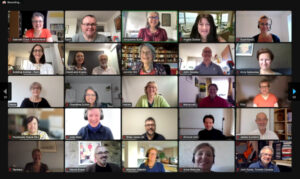In her recent newsletter Gina Campbell of miningyourmetaphors.com responded to the following question:
Research repeatedly confirms that the most important aspect of therapy, after a client’s readiness, is the therapeutic relationship. Can you talk about how Clean Language helps promote a good one?
Gina: Clean Language, with its use of the client’s exact words and gentle repetition and mirroring of the client’s emphasis and pace, gives the client an immediate sense of being deeply listened to, of being heard and understood.The facilitator’s curiosity in the client’s world is obvious, his/her attentiveness and acceptance implicit when s/he repeats words back accurately. As the facilitator asks simple Clean Language questions that focus the client’s attention on his/her exact words and images, no advice, interpretations or assumptions on the part of the facilitator intrude on the client’s experience, communicating a deep respect for the wisdom s/he holds within. The facilitator and client co-model a detailed picture of the client’s inner world, guided by what the client “wants to have happen”, quickly helping the client feel safe and empowered.
I wanted to add to Gina’s excellent answer:
As well as “the” therapeutic relationship between client and facilitator, there is another “therapeutic relationship” that, I suggest, is at least as important. The relationship between the client and themselves. The traditional therapeutic relationship is transitory but the client’s relationship with their inner world continues to develop until they draw their last breath.
The first person I know who conducted research into this other kind of relationship was Eugene Gendlin. In the 1960s Gendlin engaged in research at the University of Chicago to figure out what made some therapy sessions more successful than others. He spent a long time trying to discern consistent patterns in therapists’ behaviour but he kept drawing a blank. So he made, what I consider to be a brilliant methodological shift. He started to study what clients did. He discovered that clients who got the most from therapy experienced a “felt sense” and, given the space and time, could find words to describe that experience. These words could never describe the whole of the experience but they could resonate with the felt sense (thereby creating an in-the-moment feedback loop). Then there would be a sense of felt movement, the “felt shift“, and the person would begin to be able to move beyond their stuck-ness.
A felt sense is not necessarily cathartic and it is not necessarily an emotion. It is a kind of internal bodily awareness of subtle and vague sensations. Today we might call them embodied experiences. And if you examine the words that people use to describe their felt sense, guess
what, they are nearly all metaphors.
Gendlin went on develop a simple methodology, Focusing, that facilitated a client to engage in these kinds of inner acts.
Penny and I owe a debt of gratitude to Gendlin who strongly influenced our work, in particular the notion of ‘staying put’.
In Metaphors in Mind (pp. 288-289) we suggested that Gendlin’s definition of a ‘felt sense’ could be widened to include other forms of embodiment and that there were ways to describe an experience other than words. But the principle remains, the kind of experience the client has during (and after) therapy is paramount.
This sounds trite but I can tell you from observing thousands of therapists, counsellors and coaches over the last 20 years, many have little idea (a) what kind of experience the client is having and (b) what they can do to encourage the conditions for clients to have the kinds of experience that make a difference.
To take one example. It is rare to find someone who can distinguish in-the-moment between when a client is experiencing a problem and when they are experiencing a desired outcome. And this includes people trained in outcome orientated therapies. This may be shocking, and for many years we ignored what we repeatedly observed because we couldn’t believe it. Eventually we woke up, and the result was our Problem-Remedy-Outcome model. Over the years we expanded the model and now we use REPROCess, which adds in three more client states: Resource, Explanation and Change.
To conclude, talking about “the” therapeutic relationship – between client and therapist – presupposes there is only one, sometimes that undervalues another therapeutic relationship; the one between client and their inner world.
NOTE: I also covered this topic from a different angle in a previous blog Ent sprechen says it all.








